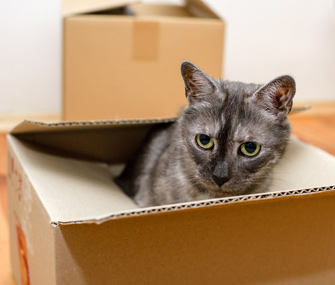Moving With Pets: 4 Common Mistakes to Avoid
Published on February 16, 2017
Skip To

As responsible pet owners, it’s our duty to do the best we can to make moving day (as well as the days leading up to it… and the days, weeks and even months following) as stress-free as possible for our four-legged friends. But even the best pet owners sometimes make mistakes when moving with their beloved animals. To help you have a successful move that works for the entire family, here are common errors to avoid.
Mistake 1: Picking the Perfect Home… for a Pet-Free Family
Maybe you’ve been house hunting for ages, and a home you absolutely love comes on the market. It’s in your price range and in a perfect location, and, now that you think about it, maybe you’ve actually always wanted to live in a multi-level home with a big, sparkling pool! And living on that busy road will actually be really convenient for your daily commute, right?Hold up. Before you sign on the dotted line, make sure you’re choosing a home that’s appropriate for your pets, keeping in mind both their current needs and potential future needs. Obviously, you’ll want to make sure the home or neighborhood is pet-friendly — a point that’s particularly important if your dog is a breed that’s sometimes restricted, or banned, by certain associations or communities.
But you should also consider things like stairs (because if your 200-pound Mastiff develops mobility problems, will you be able to get him into the living room?) and pools (which can present real hazards for pets, especially those with vision problems or who are prone to seizures). Is there a fenced-in backyard or a nearby park for walking your dog? Living on or near a busy street might seem like no big deal if you only have indoor pets, but keep in mind they could get loose, so you’ll need to exercise extra caution if you end up living on a road with loads of traffic.
Mistake 2: Letting Your Pet Run Loose While You’re Packing and Unpacking
Pets often become unpredictable when boxes start appearing and their favorite spaces in the home are disrupted. And who can blame them? They didn’t ask for any of this!Your reaction to this might be to spoil your pet with even more leniency than usual, letting him roam and explore to his heart’s content. And while a certain amount of exploring isn’t a bad idea, letting him roam free while you’re actually packing the truck can pose a real threat to his safety. Think about it: You’re distracted, doors are being propped open, everybody (including your pet, most likely) is stressed. It’s much safer to keep your pet somewhere safe during this process — maybe in a closed-off room or maybe at a friend’s house or doggie daycare. If you have no choice but to allow him to be loose, at least make sure your pet is being supervised and that anyone helping you with the move knows where he is (and isn’t) allowed to go.
Along those lines, you should also consider keeping your pet safe and confined upon arrival at the new house. Let him explore little by little so that he’s not immediately overwhelmed with all the new sights, smells and sounds, especially as you’re still getting furniture set up and boxes out of the way.
Mistake 3: Not Updating Your Pet’s ID and Microchip
If you’ve had your pet microchipped, that’s a great start, but as you’re getting ready to move into your new place, make sure that his microchip has information that will actually be helpful in the event that he gets lost. Ideally, you’ll have your cell phone number attached to it — and if that doesn’t change with the move, all the better.But even pets who’ve never strayed before may be more likely to get spooked and run away during the moving process, so it’s a good idea to put updated ID tags on your dog’s collar — and even if your indoor cat doesn’t typically wear a collar, now is a perfect time to pick one up for her and outfit her with up-to-date ID information, too.
Mistake 4: Assuming Your Pet Will Adjust Quickly and Easily
You know how we acknowledged that moving is stressful? That feeling doesn’t magically go away once the last box is unloaded — for you or for your pet. And while you might jump right back into your normal routine and have some semblance of normalcy in your life pretty quickly, especially if your job and social obligations stayed the same, keep in mind that your pet’s whole world has probably been changed. If he doesn’t immediately seem to feel right at home, that’s quite understandable, right? Cats can be especially prone to feeling the stress of a new situation.But there’s a lot you can do. For one, do your best to establish a daily routine for your pet right away — one that involves spending plenty of time with you, ideally. Regular walks (because, hey, you’ve gotta explore the neighborhood!), doing some training and using food puzzles are all excellent ways to help your pet become acclimated to his new surroundings. Plus, it’s good bonding for the two of you! And if time goes by and your pet still seems a bit stressed or just off, don’t hesitate to talk to your vet about it and see what she recommends.
More on Vetstreet:





